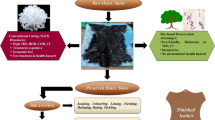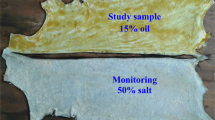Abstract
Use of sodium chloride to preserve animal skins and hides is becoming increasingly untenable due to stringent environmental regulations. In the present research work, a combination of sparingly soluble alkali and water-soluble polymer of ethylene oxide has been used to preserve skins with an objective of total elimination of common salt for preservation. A comprehensive study has been made for evaluating various parameters, such as dehydration and rehydration behaviours of skins, microbial growth, emission loads and physico-chemical characteristics of the cured skin to validate the salt-free preservation system developed. The shrinkage temperature, denaturation temperature and mechanical strength of tanned leather were analysed by using shrinkage, differential scanning calorimetric and thermomechanical analysis techniques. The new curing system has been found to be effective in preserving the skin as indicated by the various parameters studied and the final leather quality. The significant reduction in total solids content such as dissolved solids and suspended solids present in the effluent compared to conventional preservation method is evident from environmental impact assessment studies.














Similar content being viewed by others
References
Abdallaa KZ, Hammamb G (2014) Correlation between biochemical oxygen demand and chemical oxygen demand for various wastewater treatment plants in Egypt to obtain the biodegradability indices. Int J Sci: Basic Appl Res 13(1):42–48
Berber D, Birbir M (2010) Examination of bacterial populations in salt, salted hides, soaked hides and soak liquors. J Am Leather Chem Assoc 105:320–326
Durga J, Sundar VJ, Rose C, Muralidharan C (2019) Green processing: minimising harmful substances in leather making. Environ Sci Pollut Res 26(7):6782–6790
Eaton AD, Clesceri LS, Greenberg AE (1995) Standard methods of the examination of water and wastewater. 19th Edition APHA., Washington
Gustavson KH (1956) The chemistry and reactivity of collagen. Academic Press, New York, 202–245
International Union for Chemical Testing, IUC 10, ISO 5397 (1984) Determination of nitrogen and hide substance
International Union for Chemical Testing, IUC 5, ISO 4684 (2005) Determination of volatile matter
International Union for Physcial Testing, IUP 2 (2000) Official sampling procedure
International Union for Physcial Testing, IUP 6 (2000) Measurement of tensile strength and percentage elongation. J Soc Leather Technol Chem 84:317–332
International Union of Leather Chemists Societies (1958) Physical testing commission, IUP physical test methods—IUP/1,12,32. J Soc Leather Technol Chem 42–52
Iyyappan K, Ponrasu T, Sangeethapriya V, Gayathri VS, Suguna L (2013) An eco-friendly method for short term preservation of skins/hides using Semecarpus anacardium nut extract. Environ Sci Pollut Res 20:6324–6330
Kanagaraj J, Sundar VJ, Muralidharan C, Sadulla S (2005) Alternatives to sodium chloride in prevention of skin protein degradation—a case study. J Clean Prod 13:825–831
Lacevi A, Vrani E, Zuli I (2003) Clinical application of calcium hydroxide in dental pathology and endodontics. Bosnian J Basic Med III 3(4):26–29
Mwinyihija M (2012) Application and relevance of biosensors in the tanning industry. Int J Environ Res 6(4):969–984
Rai CL, Suriyanarayanan M, Sivasamy A, Chandrasekaran F (2009) Pollution prevention by salt free preservation. Int J Environ Eng 1:295–305
Ramasami T (2001) Approach towards a unified theory for tanning: Wilson’s dream. J Am Leather Chem Assoc 96(8):290–304
Sundar VJ, Muralidharan C (2009) Eco-benign skin preservation through salt substitution—a low salt approach. Desali Water Treat 11:1–4
Sundar VJ, Ramesh R, Rao PS, Saravanan P, Sridharnath B, Muralidharan C (2001) Water management in leather industry. J Sci Ind Res India 60:443–450
Sundar VJ, Muralidharan C, Mandal AB (2012) Salinity reduction through synergetic substitutes: MgO aided low salt skin preservation. Revista de Pielarie Incaltaminte (Leather and Footwear Journal) 12(4):285–294
Tiwari AK, Pisciotta A, Maio M (2019) Evaluation of groundwater salinization and pollution level on Favignana Island, Italy. https://doi.org/10.1016/j.envpol.2019.03.016
Vedaraman N, Sandhya KV, Brindha V, Tamilselvi A, Velappan KC, Sundar VJ, Kanagaraj J, Muralidharan C (2016) Deoiled neem cake as potential bio-additive for low salt raw skin preservation: a process for salinity reduction in tanneries. Int J Environ Sci Technol 13:1563–1572
Wu J, Zhao L, Liu X, Chen W, Gu H (2017) Recent progress in cleaner preservation of hides and skins. J Clean Prod 148:158–173
Author information
Authors and Affiliations
Corresponding author
Additional information
Responsible editor: Philippe Garrigues
Publisher’s note
Springer Nature remains neutral with regard to jurisdictional claims in published maps and institutional affiliations.
Rights and permissions
About this article
Cite this article
Sundar, J., Muralidharan, C. Total salinity elimination during preservation of animal skins: a sustainable approach through benign alternatives. Environ Sci Pollut Res 26, 32891–32901 (2019). https://doi.org/10.1007/s11356-019-06405-2
Received:
Accepted:
Published:
Issue Date:
DOI: https://doi.org/10.1007/s11356-019-06405-2




